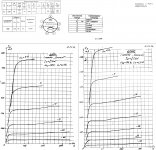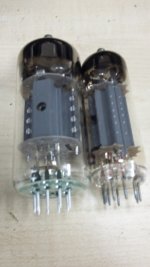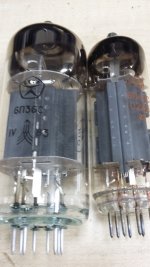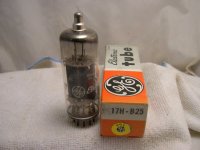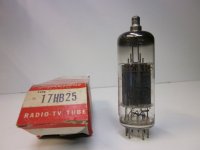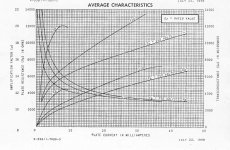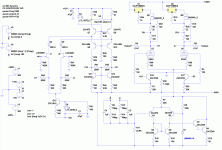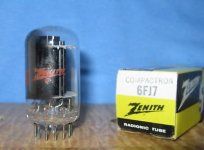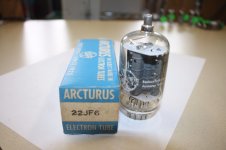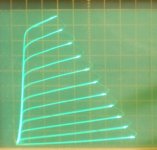Hey, after disposing of nearly 5000 6AL5's, some via slingshot or BB gun, I just bought 10 new ones in my recent trip to ESRC. They are not as useless as I thought 6 or 8 years ago.
I really shouldn't mention my recent Tardis experiments using 3A3A's and 6BK4's though. Even if successful they are just too many of them for one person to buy.
Or maybe dreams of a retirement strategy that beats the stock market. I met a guy at a very large car show in about 2007 who had recently retired from Texas Instruments. It seemed that he wandered onto a used car lot in 1975 and purchased a low mileage Plymouth for $2500, drove it home and parked it in his garage, never to see pavement again. He had the car professionally transported to the Mopar National car show in Columbus Ohio and was waiting for a professional appraiser to come and value his car. He was going to put it up for sale at the show for just under the appraisal value.
The car was a 1970 Plymouth 'Cuda with the 426 Hemi engine, one of about 50 made that year. The value at the height of the muscle car collector insanity, 1.2 MILLION!!!! That figure dropped severely in the real estate crash, then recovered slowly. The value today????? somewhere north of 2 million. Some of those cars fetch over 3 million at auction.
What do tubes cost for a Maco CB linear amp today? About $100 each. The amp takes 10 and eats them with a voracious appetite.......
Make something that sells, maybe a few hundred units a year for 10 years. If you own every tube in the world that works in your product, you have residual income forever......do that a few times and you are OK.
I really shouldn't mention my recent Tardis experiments using 3A3A's and 6BK4's though. Even if successful they are just too many of them for one person to buy.
someone must have dreams of selling tube Amps at WalMart or BestBuy.
Or maybe dreams of a retirement strategy that beats the stock market. I met a guy at a very large car show in about 2007 who had recently retired from Texas Instruments. It seemed that he wandered onto a used car lot in 1975 and purchased a low mileage Plymouth for $2500, drove it home and parked it in his garage, never to see pavement again. He had the car professionally transported to the Mopar National car show in Columbus Ohio and was waiting for a professional appraiser to come and value his car. He was going to put it up for sale at the show for just under the appraisal value.
The car was a 1970 Plymouth 'Cuda with the 426 Hemi engine, one of about 50 made that year. The value at the height of the muscle car collector insanity, 1.2 MILLION!!!! That figure dropped severely in the real estate crash, then recovered slowly. The value today????? somewhere north of 2 million. Some of those cars fetch over 3 million at auction.
What do tubes cost for a Maco CB linear amp today? About $100 each. The amp takes 10 and eats them with a voracious appetite.......
Make something that sells, maybe a few hundred units a year for 10 years. If you own every tube in the world that works in your product, you have residual income forever......do that a few times and you are OK.
"Make something that sells..."
I have this vision of an amplifier built in a bullet-proof chassis with cheap tubes plugged into the top side. It has cheap plastic knobs on the front panel with indecipherable Oriental symbols on them. The amplifier plays beautifully for 15 minutes, then begins to gradually develop grating and irritating sound effects. A chalkboard screech aura ultimately drowns out the music. It has a micro-switch G sensor within, so that violent shaking of the amplifier restores it to pristine audio quality - for 5 more minutes. Then back to the grating sounds again.
A plate current sensor detects when tube current has been interrupted or shorted. This initiates loud dying chicken screaming sounds from an EPROM data recording inside. Some large capacitors in the B+ could provide for decent tube fireworks when the tubes short out. (initiated by a stray bullet through the tubes say, or crashing to the floor) Could sell the amplifiers to gun clubs with a few spare sets of tubes. Probably won't be able to keep up with demand though. (Uh-Oh, maybe that's what the 30,000 6HB6 tube buyer already had in mind. I guess they already sell these things.)
I have this vision of an amplifier built in a bullet-proof chassis with cheap tubes plugged into the top side. It has cheap plastic knobs on the front panel with indecipherable Oriental symbols on them. The amplifier plays beautifully for 15 minutes, then begins to gradually develop grating and irritating sound effects. A chalkboard screech aura ultimately drowns out the music. It has a micro-switch G sensor within, so that violent shaking of the amplifier restores it to pristine audio quality - for 5 more minutes. Then back to the grating sounds again.
A plate current sensor detects when tube current has been interrupted or shorted. This initiates loud dying chicken screaming sounds from an EPROM data recording inside. Some large capacitors in the B+ could provide for decent tube fireworks when the tubes short out. (initiated by a stray bullet through the tubes say, or crashing to the floor) Could sell the amplifiers to gun clubs with a few spare sets of tubes. Probably won't be able to keep up with demand though. (Uh-Oh, maybe that's what the 30,000 6HB6 tube buyer already had in mind. I guess they already sell these things.)
Last edited:
Sort of on topic, should I be worried about 6S4A availability and who should I go to for some? I have a hankering for a Gilmore KGST amp for my Koss electrostatics and of course you can't get the tubes easily in UK. Or if you can Morgan Jones isn't telling as he had a stash. Any recomendations for trustworthy sources for a dozen or two tubes?
Wot on Earth are they gonna do with 40,000 6GB5's! (It ain't even That great a valve, as they were superseded by another, I'm not gonna mention.....)
MUST be some kind of OTL design I would have thought, otherwise there's lots of better valves for OT amps around...--I aint mentioning those either!
There's a Russian equivalent of the 500 I think--but the type number escapes me at the mo...
MUST be some kind of OTL design I would have thought, otherwise there's lots of better valves for OT amps around...--I aint mentioning those either!
There's a Russian equivalent of the 500 I think--but the type number escapes me at the mo...
Last edited:
6P44S is mechanical and electrical equivalent EL500/6GB5.6P36S seems to be the EL500/6GB5 equivalent
6P36S by the manufacturer data is also equal to the EL500 / 6GB5, but in practice it is much stronger and more durable tube, and mechanically completely different ("frame grid").
Hmm, these do all seem to be nearly the same:
https://frank.pocnet.net/sheets/113/6/6P36S.pdf
design: 12 Watt
max: 17 watt
https://frank.pocnet.net/sheets/049/6/6GB5.pdf
17 Watt (used to be on the $1 list)
https://frank.pocnet.net/sheets/030/p/PL500.pdf
design: 12 Watt
worst case: 16 Watt
https://frank.pocnet.net/sheets/010/p/PL504.pdf
design center: 17 Watt
design max: 24 Watt
https://frank.pocnet.net/sheets/191/2/21KA6.pdf (21KQ6 and PL/LL521)
design max: 17 Watt (21KQ6 used to be on the $1 list)
6P44C/S 21 Watt (data curves attached below)
-------------------------------------------------
Similar, but different base, 12 pin:
https://frank.pocnet.net/sheets/084/e/EL511.pdf (EL511 and 21KA6)
design: 20 Watt max: 25 Watt (21KA6 used to be on the $1 list)
https://frank.pocnet.net/sheets/123/2/21HB5A.pdf
design: 18 Watt (used to be on the $1 list)
https://frank.pocnet.net/sheets/202/3/33JV6.pdf (and 21JV6)
design: 18 Watt
https://frank.pocnet.net/sheets/123/2/21JZ6.pdf
design: 18 Watt (used to be on the $1 list)
https://frank.pocnet.net/sheets/123/6/6GY5.pdf
design: 18 Watt (16/21GY5 used to be on the $1 list)
and even this freaky tube:
https://frank.pocnet.net/sheets/123/3/38HE7.pdf
design 10 Watts (but around 15 Watts diss without the damper diode operating, pentode only = heater on pins 10 & 12 at 21 V )
(STILL on the $1 list)
17H-B25 might be similar too (on the list, similar Hickok test setup to 6GB5)
https://frank.pocnet.net/sheets/113/6/6P36S.pdf
design: 12 Watt
max: 17 watt
https://frank.pocnet.net/sheets/049/6/6GB5.pdf
17 Watt (used to be on the $1 list)
https://frank.pocnet.net/sheets/030/p/PL500.pdf
design: 12 Watt
worst case: 16 Watt
https://frank.pocnet.net/sheets/010/p/PL504.pdf
design center: 17 Watt
design max: 24 Watt
https://frank.pocnet.net/sheets/191/2/21KA6.pdf (21KQ6 and PL/LL521)
design max: 17 Watt (21KQ6 used to be on the $1 list)
6P44C/S 21 Watt (data curves attached below)
-------------------------------------------------
Similar, but different base, 12 pin:
https://frank.pocnet.net/sheets/084/e/EL511.pdf (EL511 and 21KA6)
design: 20 Watt max: 25 Watt (21KA6 used to be on the $1 list)
https://frank.pocnet.net/sheets/123/2/21HB5A.pdf
design: 18 Watt (used to be on the $1 list)
https://frank.pocnet.net/sheets/202/3/33JV6.pdf (and 21JV6)
design: 18 Watt
https://frank.pocnet.net/sheets/123/2/21JZ6.pdf
design: 18 Watt (used to be on the $1 list)
https://frank.pocnet.net/sheets/123/6/6GY5.pdf
design: 18 Watt (16/21GY5 used to be on the $1 list)
and even this freaky tube:
https://frank.pocnet.net/sheets/123/3/38HE7.pdf
design 10 Watts (but around 15 Watts diss without the damper diode operating, pentode only = heater on pins 10 & 12 at 21 V )
(STILL on the $1 list)
17H-B25 might be similar too (on the list, similar Hickok test setup to 6GB5)
Attachments
Last edited:
The plate surface of the tubes 6P36S is ~ 2x greater than the surface plate area of the tubes 6P44S, and a heating current is greater (If ~ 2A versus ~ 1.35)!
In practice, I worked a lot with both types of tubes, so I can say that 6P36S serving permanent with anode dissipation of ~ 28-30W in SE amplifier (class A1), and 6P44S not more than ~ 22-23W in equal conditions.
In practice, I worked a lot with both types of tubes, so I can say that 6P36S serving permanent with anode dissipation of ~ 28-30W in SE amplifier (class A1), and 6P44S not more than ~ 22-23W in equal conditions.
Attachments
I see, a bigger bottle for the 6P36S too.
17HB25 is still on the $1 list, cannot find data except Hickok test parameters. Looks like a 6GB5 and tests like one too (except heater V).
17HB25 is still on the $1 list, cannot find data except Hickok test parameters. Looks like a 6GB5 and tests like one too (except heater V).
Attachments
Last edited:
Seems there is a 12HB25 also, Novar, made by Toshiba.
And some data:
12.6V/0.26A(6.3V/0.52A) Ehkmax=±200V
Ppmax=13W
Epmax=6700Vpeak
Pc2max=5W
Ec2max=250V
op : Ep=100V Ec1=-7.7V Ec2=100V Ip=100mA Ic2=7mA rp=5.3kΩ gm=14mS μg2g1=6
pins : 1(G1)-2(G1)-3(G3)-4(H)-5(H)-6(G2)-7(G2)-8(G3)-9(K)-TOP(P)
heater variants : 6H-B25(6.3V/1.2A), 17H-B25(16.8V/0.45A)
A 6GB5 look-alike.
The 12HB25 heater current is rather low. (error in data?) The other htr V types are similar to 6GB5 etc. Gives a 100 mA operating point.
And some data:
12.6V/0.26A(6.3V/0.52A) Ehkmax=±200V
Ppmax=13W
Epmax=6700Vpeak
Pc2max=5W
Ec2max=250V
op : Ep=100V Ec1=-7.7V Ec2=100V Ip=100mA Ic2=7mA rp=5.3kΩ gm=14mS μg2g1=6
pins : 1(G1)-2(G1)-3(G3)-4(H)-5(H)-6(G2)-7(G2)-8(G3)-9(K)-TOP(P)
heater variants : 6H-B25(6.3V/1.2A), 17H-B25(16.8V/0.45A)
A 6GB5 look-alike.
The 12HB25 heater current is rather low. (error in data?) The other htr V types are similar to 6GB5 etc. Gives a 100 mA operating point.
Last edited:
"should I be worried about 6S4A availability " "I have a hankering for a Gilmore KGST amp for my Koss electrostatics"
ESRC has them for $3.
Judging by the Mu curves, I don't think the 6S4A is going to become a block buster for SE amps. But for P-P amps, the near linear ramping gm curves sum to near constant gm. No idea how common they are. TV tubes usually are plentiful until they get "discovered" for something.
You could always switch to the big 10 Watt triode in the 6FJ7 TV tube. 550 Volt rated like the 6S4A and similar Mu. It's on the $1 tube list even.
https://frank.pocnet.net/sheets/093/6/6FJ7.pdf
ESRC has them for $3.
Judging by the Mu curves, I don't think the 6S4A is going to become a block buster for SE amps. But for P-P amps, the near linear ramping gm curves sum to near constant gm. No idea how common they are. TV tubes usually are plentiful until they get "discovered" for something.
You could always switch to the big 10 Watt triode in the 6FJ7 TV tube. 550 Volt rated like the 6S4A and similar Mu. It's on the $1 tube list even.
https://frank.pocnet.net/sheets/093/6/6FJ7.pdf
Attachments
Well, I'd be truly impressed if you can get 200 Watts audio out of a 6FJ7,
but I think 6JF6 is a different tube.
Tubelab, maybe.... (for 3 seconds anyway, until flash-boom)
22JG6 (= 6JF6) curves in Crazy/Twin Drive:
No doubt you can get good audio using the 6JF6.
but I think 6JF6 is a different tube.
Tubelab, maybe.... (for 3 seconds anyway, until flash-boom)
22JG6 (= 6JF6) curves in Crazy/Twin Drive:
No doubt you can get good audio using the 6JF6.
Attachments
Last edited:
- Home
- Amplifiers
- Tubes / Valves
- 6GB5 and Variants as Screen Driven Amps
